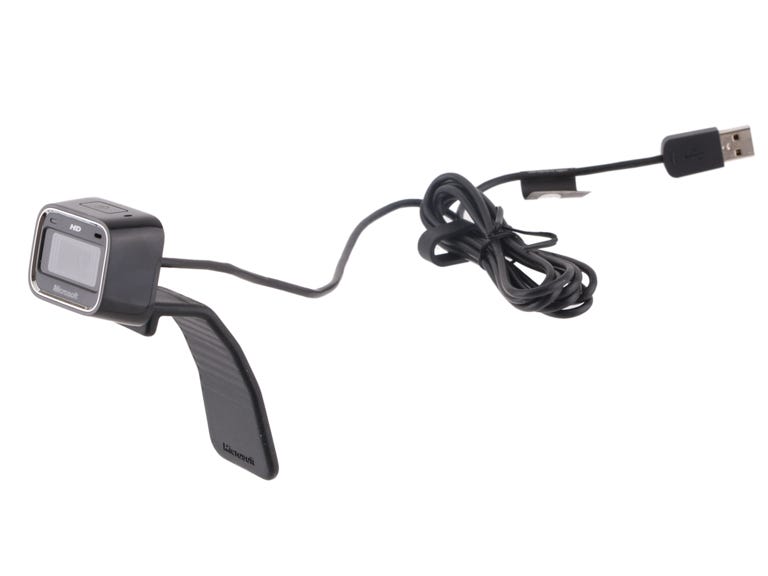 Why You Can Trust CNET
Why You Can Trust CNET Microsoft LifeCam HD-5000 review: Microsoft LifeCam HD-5000
Microsoft LifeCam HD-5000
The Microsoft LifeCam HD-5000 is the desktop version of the LifeCam HD-6000 laptop Webcam, with minor differences that account for the lower price tag. At $50, the true 720p high-def video and 16:9 wide-screen formatting are a guaranteed upgrade from most of the stock Webcams built into today's systems, and the LifeCam software boosts the entertainment value with clever 3D video overlays and effects. Its shortcomings include an auto-focus that struggles to maintain a solid picture and the video encoding is hungry for CPU processing. Minor issues aside, the LifeCam HD-5000 is a worthwhile aftermarket Webcam that deserves your attention.
The Good
The Bad
The Bottom Line
Design and features
The LifeCam HD-5000 and the HD-6000 share a similar shape and size, featuring a glossy black housing and an integrated Windows Messenger button on top, but several minor differences are easily distinguishable. First, the laptop version is supposed to travel with your laptop so it's slightly smaller than its desktop cousin. In addition, the USB cable attached to the HD-5000 is 2 feet longer than the HD-6000 to accommodate the longer travel from a tower on the ground to the top of a monitor or desktop.
The most significant difference between the physical build of the two Webcams is the base connection. On the HD-6000 laptop version, a small clip unfolds to allow for easy mounting on top of a laptop display, while the HD-5000 instead features a flexible rubber foot to accommodate a thicker full-size display. Finally, the HD-6000 offers mobile users the capability to swivel the camera 360 degrees in a full range of movement; the HD-5000 is static. Both models, however, are exceptionally small and will fit comfortably in a laptop bag or carry-on.
To install the LifeCam HD-5000, you'll need to install the LifeCam software included with the box. Microsoft tends to intermittently update the versions as well, so we recommend checking for driver updates on the Microsoft Web site prior to using it.
We should also note that Microsoft recommends stringent system requirements. The operating system must be Windows 7, Vista, or XP (SP2). The processor should be a Intel Dual-Core 1.6GHz or higher with 1GB of RAM, or the recommended Intel Dual-Core 3.0GHz with 2GB of RAM, and it needs at least 1.5GB of hard-drive space. The reason for these standards is because both the HD-5000 and the HD-6000 eat up a large percentage of system resources to encode the HD video. We tested 720p recording with a 2.27 GHz Intel Core i5 CPU with 4GB of memory installed, and the CPU usage jumped to 65 percent. That's a fairly modest configuration, but older or slower systems can expect increased CPU usage, and thus slower performance. You might not care about the performance if all you're using is just the Webcam, but if you're following along on a PowerPoint presentation, a spreadsheet, or a Web page while video chatting, you'll want to ensure that you have a reasonably beefy PC to use with this Webcam. You can also try reducing the video quality settings. And as always is the case with Microsoft Webcams, the HD-5000 and its corresponding software won't work with a system running Mac OS.
Once installed, the Microsoft LifeCam software acts as a central hub for changing settings like image quality and microphone volume, video resolution, and image adjustments. In terms of resolution, the software offers a range of settings from 160x120 all the way up to 16:9 wide-screen 1,280x720 HD video, and you also get the option to toggle TrueColor, an auto-brightness assistant that optimizes your shot in poor lighting conditions. During testing, we found that keeping the TrueColor box checked helped to bring out subtle background details that would otherwise go unnoticed. You can also uncheck the TrueColor box and use the onboard adjustments to fiddle with a range of settings including brightness, contrast, saturation, sharpness, white balance, powerline frequency, and backlight compensation.
We also enjoyed using the software's range of kitschy 3D overlays that apply visual effects to captured images and moving video. Similar to the overlays on Apple's iSight software, the effects range from carnival tricks that distort the size of your nose, eyes, mouth, and head shape to physical overlays like hats, masks, and glasses that actually sense and move along with the location of your face.
Our strongest critique of the LifeCam is the auto-focus feature that spans across Microsoft's entire line of LifeCam Webcams. The "intelligent" system automatically detects what it thinks is your face and adjusts the focus when you move, but the sensor is too delicate and constantly refocuses with even the slightest movement. The workaround solution is to uncheck the TrueColor box, delve into the minute settings and either uncheck the auto-focus option or dial in the exact focus you want, but the process is a pain and the view from the other end ultimately suffers from a slightly out-of-focus image.
Using the HD-5000 to chat is fairly straightforward once you have all the proper settings in place. We tested video chatting over several platforms including Google Chat, Microsoft Windows Live Messenger, and Skype (HD-quality unavailable) and each time we noted an overall smooth chatting experience (despite the constant auto-focusing), and the people on the other side reported few video hiccups, if any, although we did detect graininess at lower resolutions. In addition, the LifeCam software also allows for audio recording using the built-in microphone, and we're impressed with its capability to pick up minute sounds while filtering out external background noises.


